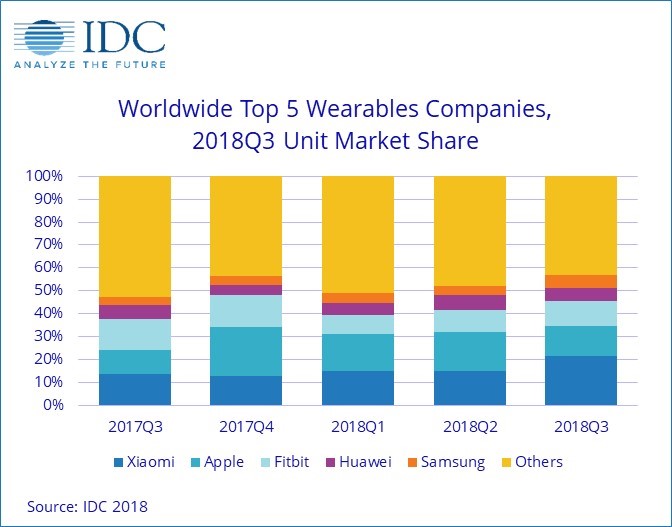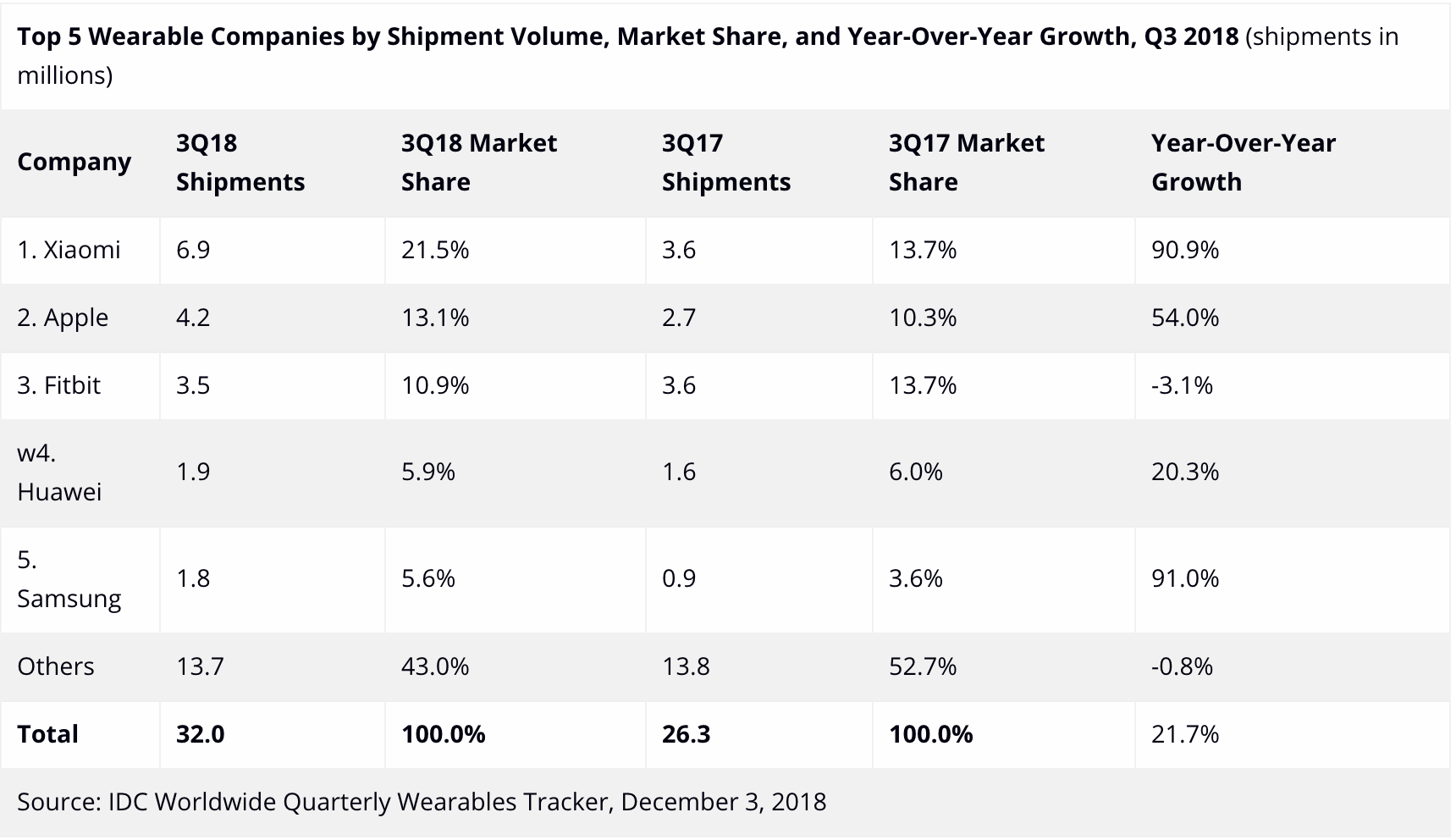
FRAMINGHAM, Mass., December 3, 2018 – Global shipments of wearable devices reached 32.0 million units in the third quarter of 2018 (3Q18), up 21.7% from the previous year according to data from the International Data Corporation (IDC) Worldwide Quarterly Wearable Device Tracker. New products from the likes of Fitbit, Garmin, and Huawei helped the basic wearables category return to growth during the quarter. Another driving factor was growing demand in markets like Asia/Pacific (excluding Japan), which accounted for more than half of all shipments and grew 21.4% over the previous year. Meanwhile, the second largest market, the United States, saw its year-over-year growth decline 0.4% as it transitions from a market driven by new users to one that relies on replacement devices and upgrades.
"Many of the new basic wearables include features like notifications or simple app integrations that bleed into smartwatch territory. This has helped satiate consumer demand for more capable devices while also maintaining average selling prices in a market that faces plenty of downward pressure from low-cost vendors and declining smartwatch pricing," said Jitesh Ubrani senior research analyst for IDC Mobile Device Trackers. "However, this resurgence of basic wearables should be watched closely as these wearables have historically been popular due to their low-price points and simplified set of features. As more features get added and as the price differential between basic trackers and smartwatches narrows, brands could potentially move consumers upstream to smartwatches."
"Meanwhile, the smartwatch market also evolved during the quarter as the two largest smartwatch brands, Apple and Fitbit, continued to delve deeper into the healthcare market," added Ubrani. "The healthcare market is quickly becoming the next frontier for wearables brands to conquer. With heavy regulation and greater scrutiny, this segment will likely be the one that staves off value brands, allowing the market leaders to further cement their lead."
"The wearables market benefits from geographic differences," said Ramon T. Llamas, research director for IDC's Wearables team. "China – the largest market for wearables and more than double the size of the U.S. market – has grown thanks to strong device development and experimentation, low-cost products, and strong demand for basic devices to draw in new users. Meanwhile, the U.S. market – while slowing down – presents an opportunity for vendors to offer more featured and higher-priced devices to current users and possibly to recapture old ones. In between the two markets are many other countries in various states of development, and this allows vendors to take different approaches to meet demand. Combine these geographic differences with the new product announcements and releases, and the stage is set for a strong holiday quarter."
Top Five Wearables Companies in 3Q18
Xiaomi grabbed the top position during the quarter thanks to the success of the Mi Band 3 and significant expansion beyond its home country of China. Though typically China accounts for well over 80% of Xiaomi's shipment volume, this quarter that share fell to 61% as the company managed to grow its presence in other markets such as India, Europe, and Middle East & Africa.
Apple managed to launch its Series 4 Watch, its first watch approved for medical use, towards the end of the quarter. The new design and sizes along with the latest version of Watch OS were welcome changes though the latest series only accounted for less than 20% of all Apple Watch shipments. The reduced price on the still affable Series 3 accounted for the majority of Apple's shipments during the quarter.
Fitbit's latest devices, including the Versa, Charge 3, and the Ace, helped the company slow its decline compared to previous quarters. In particular, the success of the Versa has allowed the company to once again become the second largest smartwatch vendor and IDC expects this to continue in the near term. Looking ahead, the company's focus on improving the quality of sleep for its users will remain one of its core strengths and key differentiators in the market.
Huawei finished just ahead of Samsung to maintain its number four position worldwide, emphasizing its newest TalkBand B5 series of wristbands. This maintains its unique approach of combining a Bluetooth earpiece with a fitness tracker. Meanwhile, its Honor sub-brand introduced a new set of earphones that tracks heart rate during workouts. Overall, however, the majority of Huawei's wearable devices remained within its home country of China.
Samsung closed some of the gap with Huawei and stretched its lead past other contenders yet remained in the fifth position for the second consecutive quarter. The company launched its next generation smartwatch, the Galaxy Watch, marking the first time that a wearable device moved away from its traditional "Gear" moniker to the "Galaxy" sub-brand, alongside its smartphones and tablets. Still, Samsung relies on its Gear S3 and its smart Gear Fit wristbands to drive volumes, and its connected wearables posted continued sequential growth.
Top 5 Wearable Companies by Shipment Volume, Market Share, and Year-Over-Year Growth, Q3 2018 (shipments in millions)

About IDC Trackers
IDC Tracker products provide accurate and timely market size, vendor share, and forecasts for hundreds of technology markets from more than 100 countries around the globe. Using proprietary tools and research processes, IDC's Trackers are updated on a semiannual, quarterly, and monthly basis. Tracker results are delivered to clients in user-friendly excel deliverables and on-line query tools.
Email Newsletters
Sign up to receive TelecomTV's top news and videos, plus exclusive subscriber-only content direct to your inbox.




